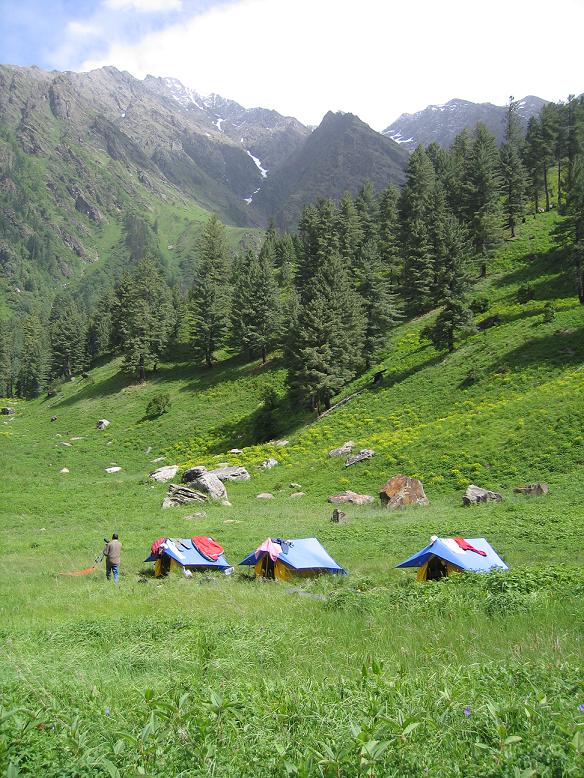
This article will share a personal perspective around working on these issues where I have been involved as an advisor to GHNP and living in a rural Kullu Valley for part of each year since 2003.

The Forest Department (FD) wanted to encourage locals to become stakeholders in GHNP and programs were developed. These included helping in the establishment of a local NGO; micro-credit financing for women; training in alternative livelihoods such as working in forest nurseries (cultivating trees, shrubs, medicinal herbs), developing vermicomposting (purchased for FD nurseries); and developing local products for a wider market (rajama/red beans, apricot seed oil).
We began training young village men in trekking skills to develop jobs in ecotourism. Friends from the US and Germany came to GHNP and were very supportive giving constructive feedback so the men could learn their trade. This provided some men with more consistent work and helped develop GHNP-related livelihoods. Friends of GHNP was created to develop the Park’s extensive website as well as educational materials (posters, brochures, GHNP branding, videos). A Kullu tour company, Sunshine Himalayan Adventures, further trained the local men and marketed the Park using the internet.
These activities in the first years of the Park’s opening, helped some locals change their attitudes about GHNP and the value of nature conservation. In 2003 my wife, the writer Kamla K. Kapur, and I decided we wanted to live in India and with the help of Kullu friends we established a life for ourselves near the Park.
I continued working with GHNP and locals, trekking over 1,200 km with Sanjeeva in GHNP. But actually living in the region exposed me to the serious hardships of many poor villagers experienced. It was obvious how difficult it was for them to be concerned about protecting the Park, when getting enough to eat, having sufficient firewood to cook and stay warm, and dealing with a pervasive lack of health care were the immediate and crucial concerns. A big shift occurred when a young pregnant woman from a remote, higher village sadly died from a breach birth near our village. Talking to locals about health care, I discovered that it was not readily available with the exception of a more distant government hospital in Banjar and a small surgery clinic in Jibhi run two weekends a month by Lady Willington Hospital (LWH).

My Himachal has expanded its health programs in the past two years to include support for local nature conservation and education. MH has also brought in Indian and foreign student volunteers who have worked on ecotourism development and job creation, including MBA students at the SP Jain Institute of Management and Research (Mumbai). We are expanding our network of foreign advisors in national park and community development, and rural economics. We also interact with other environmental NGOs on watershed conservation and ecotourism issues. My Himchal has taken over the responsibility for maintaining the GHNP website and is currently updating it as a prime source of Park information. With the recent notification of GHNP’s placement on the UNESCO World Heritage Site Tentative List, there is even more MH focus on support for the Park.

The ground teams My Himachal have developed lay the foundation for us to collaborate with villagers, friends, and associates in different areas of HP. This will further our goal to both uplift the people and protect the unique Himalayan environment of this beautiful state.
For more information:
My Himachal: www.myhimachal.com
GHNP: www.greathimalayannationalpark.com
©2009, Payson R. Stevens.
Payson R. Stevens is an American trained in the earth sciences and art. For over 25 years he was involved with working with NASA, NOAA, and the USGS on global change issues. He lives half the year, with his Indian wife, in a remote area of the Kullu Valley, where he paints, writes, and does seva work. More of his artwork can be seen at www.energylandscapes.com

Earth Scientist, Author, Hiker and Traveler, Payson is a trained earth scientist and founder of InterNetwork, Inc and InterNetwork Media, Inc. Stevens has been an advisor to Great Himalayan National Park since 2000.



I plan to and will luv to work for the issues concerned. Have been to the area and am concerned about its opening to tourists who bring in loads of consumables with them which is trashed there. Am also concerned about growing popularity which might ruin the area in future.
Regarding to Responsible Tourism Alliance (Track of the Tiger company), Could you please send me the email address or the contact that I can find out some more information about this